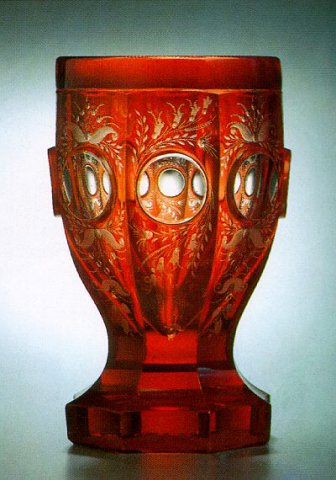Tradition of the Bohemian Glass production
The history of the glass production in Bohemia (former Czech lands) in the central Europe starts in about 3rd century BC. The strong development in this industry started in 8-10th century when the glass furnaces mostly used to produce the glass costume jewelry (bijouterie).The first written information about the production of the colored and painted glass for windows comes from 1276.
The first development of the glass industry in Bohemia starts in the second half of 14th century when about 20 manufacturers and glass furnaces have been registered. These manufacturers used to produce mostly highly decorated stemware glass. Further development of the glass production occurred in the end of 16th century focused on engraved and painted decorations.

The mass glass production in the Czech Republic started in the beginning of 20th century by way of automation of the production using the modern and sophisticated complete production lines. From this period most famous well-known crystal glass trademarks came into the world market being connected with the Czech Republic. Lately there were constructed two fully automated glass factories belonging to the biggest ones in the world and many of the others have been modernized.Long tradition of the Czech crystal glass is based mainly on the hand made products of the highest craftsmanship, skills, art and quality standards of the Czech glassmakers, glass blowers, glasscutters, glass decorators and designers.
.
Forest Glass
Sources of Central European glass can be found in Corinthian excavations from the 11th and 12th centuries. These primitive glass styles spread through Italy to the East - to Istria - and to the North - to Germany, Czechia and Holland. At the time the production of arts and crafts ceased to be the sole preserve of monasteries. Glassworks started being built in forests, as workers searched for more wood to feed their furnaces. And the darkest forests were colonized in this hungry quest.

These glassworks produced "forest glass" - glass of a green shade caused by the imperfect refining of the raw material - potash and quartz sand. Potash was gleaned from the ashes of burned wood and used as a melting material instead of soda. Potash glass is typical for this Central European area. The first sign of Czech type of glass is from 15th century. In the 16th century, glasses inspired by Venetian Renaissance glass - hempen and rammer - were produced for the German and Italian markets.
.
Engraved and Cut Crystal
In 1588 the emperor Rudolf the 2nd, patron of the bohemian alchemy, invited to Prague Mr. Ottavio Miseroni who founded the first cutting workshop for diamonds. It was the main pre-condition for the big development of the newly arisen way of decorating the glass- "engraving" - the cutting of glass on the engraving appliances by little stone or copper wheels. The most important craftsman in Prague of these times was Caspar Lehmann who became an imperial court engraver. Thus Rudolf the 2nd made himself the generous patron and Prague the main center of this new glass art craft. From Prague it expanded to the Central, later to whole Europe. During the 30 years war many artist and alchemists had to escape.
During last third of 17th century the engraving of glass developed very quickly and two big centers were arisen: Jablonec area and Česká Lípa area, were are situated large resources of the pure sand and wood (for potash and furnances), as many occasions for escaped alchemists to hide. Sandstone domes and towns hiden deeply in the forests were nearly inaccessible for war predatory bands. Tradition and skill of glass engravers has survived in these areas till actual days, as the ability of the landscape to secrete. Large parts of area served in the cold war era for military purposes; nowadays are wild, nature, nearly depopulated and therefore ubelievable beautiful.
The end of 17th and the beginning of 18th century brought the big success and the world glory of Czech glass. There was a strong development of specialized Czech production, the refining of glass by painting, engraving and cutting. In popularity Czech glass of these times put into the shade the favorite Venetian glass. The engraved and cut cups did not have only a practical function but made a good representational function as well.
By the end of 18th and at the beginning of 19th centuries the English, Irish and French lead crystal started to compete to Czech glass. Lead crystal was glass with the high contain of lead, very suitable for cutting having been softer, heavier and with high refractive index.

After the decline of business and the commercial isolation caused by Napoleonic Wars, Czech glassworkers started the successful come back to the lost markets. They improved actually melting glass and learned how to make lead crystal. They created their own style combining the simple English diamond cut with the engraved decoration, later they introduced more difficult and complicated cut decorations. After the further crisis in the middle of 19th century Czech glass re-developed at the end and in the beginning of 20th century.
.
Bohemian crystal art
Framed by Germany, Austria, Slovakia and Poland is a precious little star called the Czech Republic, historically known as Bohemia - the former kingdom of central Europe. Shaped culturally by its famous king and emperor of the Holy Roman Empire, Charles IV, the Czechs sustained, despite the 50-year long communist influence, their centuries-long fame in the production of world-class art made of hand cut lead crystal.
Crystal chandelier parts such as prisms/trimmings, bowls, arms and clad crafted in the Czech Republic are eagerly sought by interior designers and well known chandelier manufacturers all over the world. Nevertheless, for a chandelier to carry the label "Bohemia Crystal", the entire chandelier must be made in the Czech Republic. Also, it must pass or exceed very strict export quality standards set by the Czechs to enforce and protect the well-guarded trademark “Bohemia Crystal”.

Crystal, by definition, is glass of superior quality and high degree of brilliance. Not all crystal is the same because its quality, color and brilliance strongly depend on the composition and proportioning of raw materials, and associated technological process, all of which are traditionally kept a secret to protect the formulae.
To give the crystal a dramatic or exotic appearance, a specific blend of colors is added to the basic crystal glass formulae to create transparent pink, ruby red, light blue, cobalt blue, amber/topaz and green undertones. The richer is the design, the more facets to reflect light, the more precise the cut, the more valuable the crystal creation. Bohemia Crystal glass creations are further beautified with gold-plated and enameled designs to give them the ultimate statement of timeless beauty and elegance.
.
Painted Glass
Painted glass has taken a great part in the history of the Czech glass-work. High level of the craft of Czech glass painters as well as creations of Czech art glassmakers belongs to absolute top of world production in branch. High enamel is quite new technique in the historical context, but nowadays it dominates in the industrial production of painted glass.
There have been at lest two reasons to paint glass. First has been to make the product more attractive and the second has been the attempt to cover possible defects in glass. Glass has been decorated with painting since the ancient Egypt, but not until the period of Roman Empire fired glass emails have been used. The tradition of painted glass in the Czech countries began in the renaissance. The painting with glass emails based on Venetian style came to Bohemia probably from the South of Germany. However, the use of the wide spectrum of national motifs sat the peculiarity of Czech renaissance painted glass.

In the baroque period glass painting changed nearly to folk art, especially welcoming goblets and square bottles for liquor were very popular. In this time glass painting could not compete with much more advanced engraved glass. The great break in quality and quantity of painted glass came as late as the period of rococo, when the production of glass imitations of more expensive porcelain was dominant. Typical rococo motifs are painted mainly on the white opaque opal glass. The nineteenth century brought the vogue of historism style, renaissance glass was imitated and also the Arabian and Persian inspiration influenced the production significantly.
.
High Enamel
At the end of nineteenth century historism receded and the progressive style of Art Noveau, which was the period of creative and technological experiments, replaced it. At that time the high enamel was used for the first time, but only as the subsidiary technique, implementing brilliant floral motifs of incredible skill and elegance. Soon after the Second World War the era of unprecedented boom of painted glass began especially in Nový Bor area. The reason was huge run on the painted glass in associated socialistic countries and also in friendly Arabian countries. Beside the copper ruby glazed glass the high enamel painting got strong position. Blue, green, ruby or opal glass has been decorated by abundant décor on golden under layer, consisting of roses painted with high enamel and garlands made with relief enamel.



